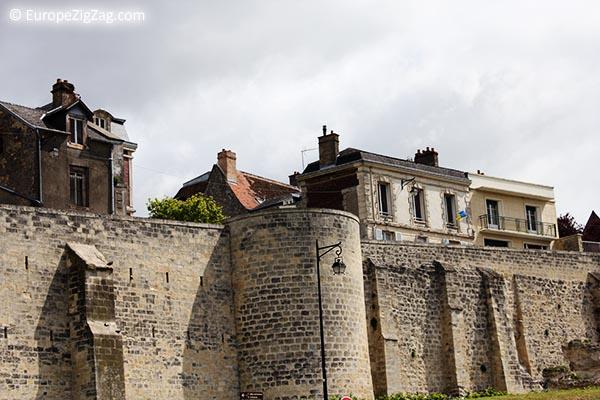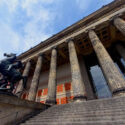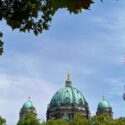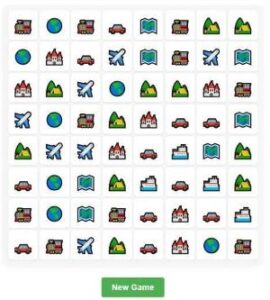The same question kept returning in every place we visited but the only answer I could come up with was: “Everything that one has back home and that is amplified in importance when you are not there”. The question was “What’s so special about this place?”. When reflecting more on the answer, it developed into the following “Every place we visit is the home of others so their perspective is reversed when they travel. A small fact for some but a huge example of the importance of impressions and how they relate to where you are from”. On a road trip you are presented with cultural differences in a gradual way. You make your way through landscapes and cities, countries and as you do so the differences and similarities between people gradually change. A road trip can therefore be seen as a teaching experience in tolerance as well as appreciation of people.
The region south of the English channel is still relatively unexplored by the many weekend tourists looking for action in cities such as Amsterdam, Berlin and Paris. Yet French Normandy and Belgium has so much to offer as seen in small villages with medieval and sometimes Roman origin. There will be centuries-old buildings to greet you and remains from historical events can be found scattered around Normandy. This is the type of trip you undertake to leave you in awe when returning home, with an urge to go soon again to explore the villages and cities you missed the last time. For every question you manage to answer during your escapades, you will stumble upon new ones as you learn about the people, customs, and social life. In short, this is a trip you go on to see what life can be like in smaller villages and cities in a very notable piece of continental Europe, far away from the metropoles that so many venture to.
Short distances between different cultures
We started off by crossing the border to Belgium soon after we left Amsterdam. Netherlands is a small country and we were still chatting away with the excitement of getting on our way. You would think a road trip would require plenty of miles being covered to find different experiences. If you choose the region around northern France, Belgium and Netherlands, that’s not really the case. No sooner have you left one fun city before you are able to enter a new one. Sure enough the Dutch nature is monotonous but this is more than compensated for if you travel through French Normandy which has rolling hills and offers a postcard-like landscape.
We started out from Amsterdam, that Dutch gem of a city also called the Venice of the North, along with Bruges, Hamburg, and Stockholm that share the same title, only to mention a few. Bruges is just three hours away from Amsterdam by car. An excellent example of the short distances between historical cities in Belgium and Netherlands. You could also argue that with such short distances between Amsterdam, Bruges and other cities in the vicinity, it does not come as a great surprise that many tourists flock to this region in Europe. The plethora of things to do and see is more than enough for most tourists.
As we entered Bruges I was quickly reminded that this city has a small historical center that resonates of rich medieval times. If you are a foodie, stick close to the Old Town square which has restaurants on two of four sides. The other two sides boast The Belfry which is a 13th century building, and The City Hall, built in the 14th century, so you can rest your eyes on beautiful façades as you enjoy your food and drink. When you are done with feasting on the sights and food in Bruges, it is time to travel westward and make your way along the coast towards Dunkirk and Calais. We spent the first evening of the trip eating Flemish food in a restaurant on the historical square and topping it with some wine in a nearby cocktail bar. The following day was planned with an early start in the morning to make our way into France quickly.
It turns out that travelling to France by car involves quite frequent road tolls. After we passed a few we starting taking count of the seemingly endless stream of coins that we had to feed the road toll machines with. A note for you if you are planning on a road trip through France – Keep plenty of coins readily available and budget for the road tolls. It is not uncommon for road tolls to cost up to six euros each. The money quickly stacks up as you zig zag around France.
Le Touquet
Le Touquet is a small city along the French coast and this is where many French people from cities such as Paris flock in the summer months, along with English families and youths that make it across the English Channel. We arrived there with no expectations and after having parked the car, went for a leisurely strawl down the main street leading to the water. Expect plenty of bars, restaurants and an open stretch of beach. This city welcomes thousands of people in the summer months and the different types of travellers that choose to have a holiday at Le Touquet is apparent in the available choices for accommodation. By walking around the compact city center you quickly notice how hotels, bed and breakfasts as well as youth hostels are sharing the limited space without interfering with the small town feeling. Le Touquet definitely caters both for the calmer families with children as well as the younger and more active crowd that is more interested in spending their time and cash on nights out. Not that there is a lack of recreation in daytime. Sailing and kite surfing as well as lounging on the beach is hugely popular. This thanks to the wide and long sandy stretch Boulevard de la Plage. There is even a golf course available in the south of the city for the golfers aching to practise their swing. That is a nice touch which adds to the rich variety of activities. As Le Touquet was but a pit stop for us we quickly went on our way after having indulged ourselves with waffles with jam and a walk along the beach. The next stop was much further south and closer to the historically known Normandie, namely Honfleur.
Honfleur
Honfleur is one of the rustic little villages in France. Get ready for eyecatching old buildings and a harbour full of sailing boats and surrounded by restaurants. Honfleur may be small. Honfleur may also a scarce variety of view. But taken as a whole it makes up for all that with the cozy ambiance and the quality of the same few views. This is a village to fall in love with, its simplicity being its beauty. It has a small town square and a harbour neatly enclosed by houses that are hundreds of years old. If you fancy a visit to Honfleur, try to stay two to three hours to properly appreciate the calm rhythm of life there. We stayed merely a night and all agreed that a longer stay would have been optimal.
Normandy – A crossroads in history
With all these small cities and villages in Normandy, one can forget about the more turbulent times that helped to define what Normandy is, a crossroads in history. It shouldn’t come as a great surprise that Normandy is known in the twentieth century for the landing of allied troops in June 1944, one of the largest events that marked the beginning of the end of World War 2. As such, the Normandy landscape shows plenty of signs of those turbulent times. From the landing beaches such as Omaha Beach with its impressive monument to pay tribute to the D-Day landings, to the museums that are scattered around, and the bunkers and statues that are erected along the coastline. Omaha Beach lies well tucked into the Normandy landscape. It is a long stretch of beach that allowed for x thousand soldiers to land on 6th June 1944. This marked the beginning of the liberation of Europe in the second world war.
But hold your horses.
Normandy was scarred not only in modern times but also in medieval times during the age of turmoil that led to the conquest of England by the Normans. If we look even further back we see that during the Roman era Normandy was also part of the Roman empire. The Roman grip on Normandy lasted until the 4th century A.D when the area became independent of Rome. This can be seen with the remains of the Roman amphitheatre in Lillebonne a few kilometres from Le Havre.
No matter what time period you choose to consider, chances are that there are visual remains that stand out in the landscape and cities of Normandy to mark the historical period. Normandy was a place where plenty of people passed as well as settled. All these people and historical eras have left traces in Normandy, clearly visible in old settlements that remain to this day, such as Vieux-la-Romaine just south of Caen. This old settlement also has a museum, www.vieuxlaromaine.fr.
So Normandy is a treasure cove for those curous about cultural heritage and sights that span the better part of two thousand years. Vieux-la-Romaine is an interesting example of this. What was originally a Roman settlement can still be seen today as a village in our modern times. That is quite worthwhile to ponder on if you happen to pass through the village and stop for a croissant and a coffee. Who walked the area in antique times, how did they live and what did daily life look like? Ah well, be sure to enjoy your coffee while it’s still warm. Vieux-la-Romaine is only one example of retreats in Normandy that have something out of the ordinary to show you. On the same historical note, you might want to consider visiting Bayeux which has the Bayeux Tapestry, an embroidered cloth that is 70 metres long and 50 centimetres tall. It depicts the events that unfolded before the Norman conquest of England around the 11th century A.D and as such is a great record of historical events. The fact that it resembles a modern comic strip only makes it more funny. It also gives you a chance to brush up on your school Latin as you try to decipher the quotes that are literally vowen into the cloth in a chronological left to right order.
Bring your camera and sportsgear
If you want to combine your intake of history with interesting activities, go to Rouen in eastern Normandy, a city with Roman ancestry that also played an important part in Medieval times. There you can walk around and admire hundreds of medieval half-timbered houses. If you want to be really sporty you could visit the small village Clecy which is known for the wide range of outdoor activities, kayaking and climbing. All these places combined with the famous Normandy food and drinks (i.e. wine and cider) will appeal to most people.
Travelling by car through French Normandy and Belgium
One of the undisputable charms of road trips is the possibility to find unexpected sights. The highways in Europe will certainly take you from point A to point B with very little hassle and fast enough. But a road trip is not really about getting around fast. It is more about enjoying the ride which includes the chance to enjoy the scenery. Let’s consider how we happened to come across the French city Laon.
The coastline along north of France and Belgium has some spectacular vistas to offer, in particular around Calais where there are steep cliffs next to the sea.
French Medieval Charm in Laon
The following occurred as we entered Laon. We only decided to get off the highway because we saw the cathedral towers in the distance. As we found our way to the city we were greeted by dozens of Morgan cars. That is, the classic Morgan 4-4 variant that was introduced in 1933 at the Olympia Motor Cycle Show. Set in a cityscape like Laon this is quite a feast for the eyes. The city has around 25,000 inhabitants, is set on a hill with a city wall from Medieval times, complete with an Old Town with cobblestone streets. Originally a Gallic village that was conquered by the Romans (in the times of Julius Caesar) this place has seen historical eras come and go. The city is only 55 km away from the much more famous city Reims and some 140 km away from Paris.
The charm of Laon is that it is so small and lacks the crowds of tourists. Now add a few hundred vintage cars all huddled together with their owners for the yearly vintage car rally and the net effect is a fairly spectacular show. The entire scene was as if taken from the early 1930ies.
Ghent – The second gem in Belgium
Ghent was our last stop in Belgium and a worthy one at that. We chose to stay close to the historical center with the iconic castle a few hundred meters away We quickly made our way to the central canals with the old buildings that all have their stories to tell, and which the boat tour operators were more than happy to share with us. Ghent is not as touristy as Bruges, although both have their fair share of sights have made it into travel guides. Yet Ghent is larger and has more of a city vibe to it, as compared to the cuteness of Bruges which is a postcard-like village.
So go on a road trip. Not only to see new places but to understand your own home and your own cultural influences better.
Allow yourself to get lost along the streets in Ghent, and stop for the occasional drink and snack. There are plenty of bars with a Belgian authentic feel to them. This we did the last evening of our road trip before we were to set out for the final leg of the road trip the day after.
The possibilities
As we crossed the border to Netherlands after five days of zig zagging with a car in Belgium and French Normandy, one thing is very clear. The combinations of cities, villages and landmarks to visit and experience is huge. Suffice to conclude you cannot have “done Normandy and Belgium in a road trip”. You may have experienced a variant of a road trip in the area, but each road trip is unique. And that’s the beauty of it. Expand on the area of your region of intereste, and you quickly come to see just how road trips in Europe can be rich in experiences – And provide you with a fresh perspective on your own home city.
Perhaps this is also the most important thing to take with you from this blog bost – Road trips in Belgium and France will be thought provoking experiences and you will face different historical events and see daily cultures that will certainly differ from what you are used to back home. This region has plenty to offer for the curious mind with a casual interest in culture and history.
So go on a road trip. Not only to see new places but to understand your own home and your own cultural influences better.














